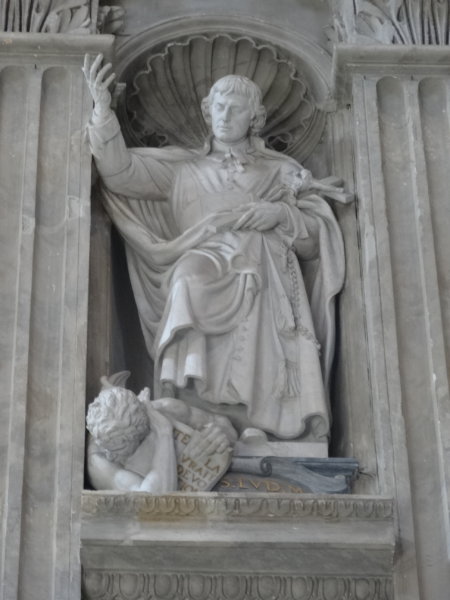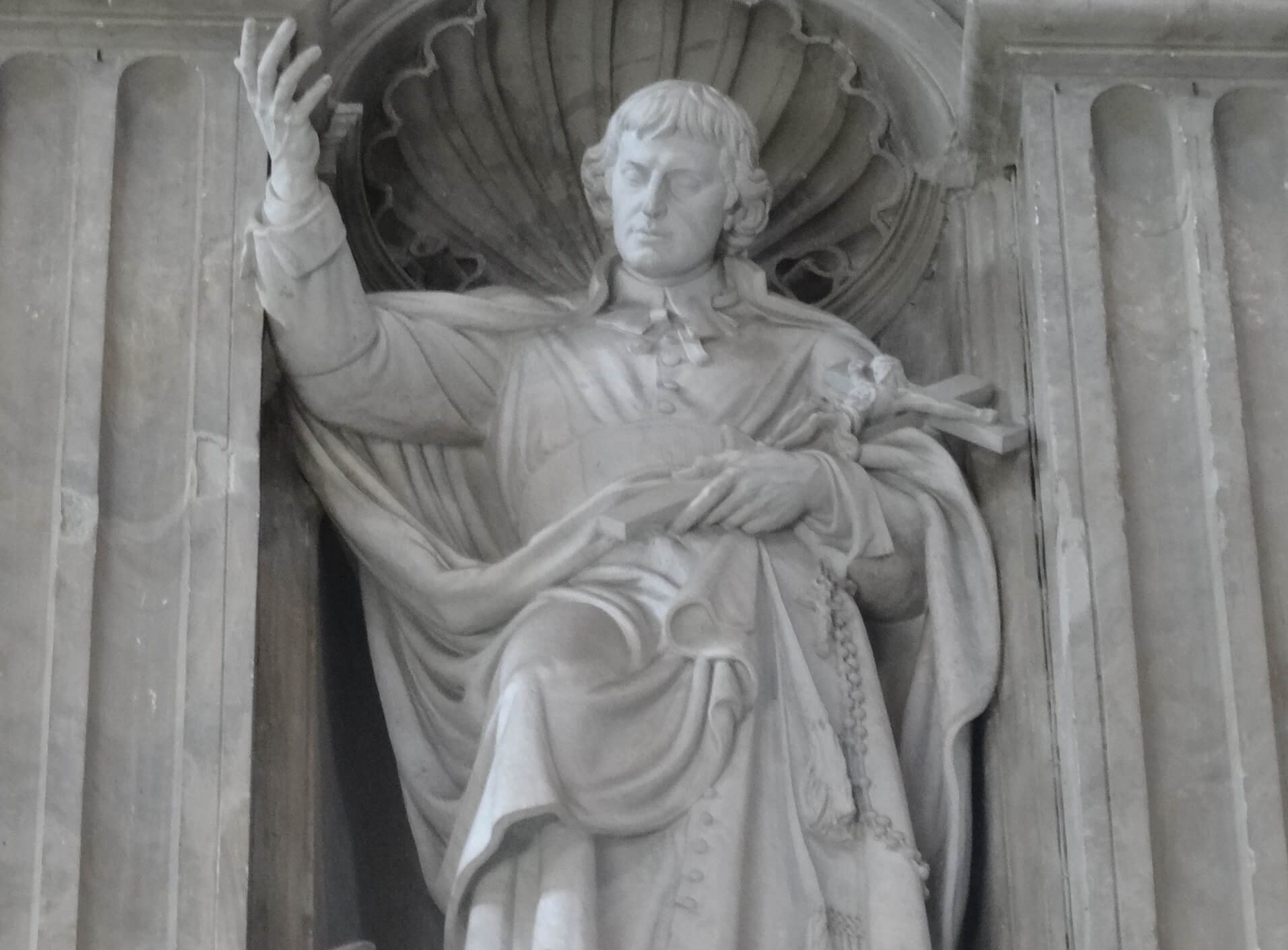Three hundred and fifty years ago today, on January 31, 1673, the mystic poet of Our Lady, the great Breton missionary of Louis XIV’s century was born in Montfort-sur-Meu, north-western France: Saint Louis-Marie Grignion de Montfort.

He studied theology at the Sorbonne University of Paris and was ordained priest at the age of 27. Named apostolic missionary in 1706 by Pope Clement XI († 1721), he spread the cult to the Blessed Virgin Mary and founded the Daughters of Wisdom (1703) and the Company of Mary or Montfort Missionaries (1705). He died at the age of 43, on April 28, 1716, preaching a mission in the village of St. Laurent-sur-Sèvre. After a short life, which was surprisingly intense and fruitful, but singularly painful, he was exalted by some, misunderstood by others.
Pope Pius XII canonized him in July of 1947, considering in his brief homily, at the basis of the perfection and surprising results of this saint, “his most ardent love for Christ and the blazing, solid and right devotion to the Mother of God.”[1] Pope John Paul II’s motto, Totus tuus, was inspired by Grignion de Montfort’s doctrine. Among the saints of his time,
and perhaps of all times, Grignion de Montfort was probably the one who went furthest in the theological study of devotion to Mary at the service of Christian life… The Treatise on True Devotion to the Blessed Virgin remains the classical book of Marian devotion.[2]
Our missionary is also the author of a grandiose song book of over 23,000 verses, 163 alternate rhymes, composed for the people to sing during his missions in Poitou, his native Brittany and the Vendée. That is why we could call this saint a patron of popular religious music. Ever since he was a seminarian, according to his fellow disciple and first biographer Jean-Baptiste Blain († 1751), Grignion de Montfort “in his retirement also was interested in composing spiritual cantiques (hymns) which later were used for his missions.”[3]
https://youtu.be/O6l4w2F0BmQ
The collection opens with a hymn entitled Usefulness of hymns, in which the apostle-missionary explains why to sing. In summary: hymns give glory to God and He likes it because He loves singing. The first to do so were the angels; in singing we become like them. Singing lights love’s fire on earth and thus earth answers heaven; the hymns must therefore be good. Singing brings joy and God wants His servants to be happy; therefore the whole Church sings, even in the office of the dead.
This has been happening since the first Christians. In fact, St. Paul writes: ‘Rejoice in the Lord always’ [Phillip. 4,4]. So did the Blessed Virgin and the saints.
But hymns are above all useful for the soul: they enlighten the mind, pacify the heart, refresh the memory, restore courage, fill with joy, open the heart to the Holy Spirit, charm away our ills, renew our works, ready us for great tasks. Song frightens the devil and the world: it chases the troubling evil spirit away, corrects the licentiousness that the world introduces into it to dishonor God, such as that of drunkards, thus eliminating the poison that could intoxicate humanity by scandalizing the weak and defenseless and defeating the world, true sewer of filth. Finally, the friends of God are exhorted to always stand firm against the devil and the world, and always to sing the Lord’s glory.
These properties of popular religious hymns are also to be found in the teaching of Pius XII. Completing the prescriptions of Popes Pius X (cfr. Tra le sollecitudini, 1903) and Pius XI (cfr. Divini cultus sanctitatem, 1928), the Pastor Angelicus also holds
in honor that music which is not primarily a part of the sacred liturgy, but which by its power and purpose greatly aids religion. This music is therefore rightly called religious music. The Church has possessed such music from the beginning and it has developed happily under the Church’s auspices. As experience shows, it can exercise great and salutary force and power on the souls of the faithful, both when it is used in churches during non-liturgical services and ceremonies, or when it is used outside churches at various solemnities and celebrations. The tunes of these hymns, which are often sung in the language of the people […] give a kind of religious grandeur to their more solemn assemblies and gatherings.[4]
Did St. Louis-Marie compose his hymns inspired by liturgical hymns? “There are also popular religious hymns which derive their origin from the liturgical chant itself,” says Pius XII.[5] Are the hymns by the apostolic missionary in conformity with the Magisterium of the Church, against “the joyless austerity, the dark terror, the proud depression of Jansenism”?[6] The Pope writes:
If hymns of this sort are to bring spiritual fruit and advantage to the Christian people, they must be in full conformity with the doctrine of the Catholic faith. They must also express and explain that doctrine accurately.[7]
Are the verses by our missionary, even in the French of his time, easily understood? Popular religious hymns “must use plain language and simple melody and must be free from violent and vain excess of words,” writes Pius XII.[8] “Despite the fact that they are short and easy, they should manifest a religious dignity and seriousness.” Grignion de Montfort, attentive to the preaching of the Gospel, writes these sacred canticles in accordance with these directives and chooses beautiful, popular melodies to sing them to.
“The good father of Montfort” — as he was called by simple people — “proposes consecration to Christ through the hands of Mary, as an effective means for Christians to live faithfully their baptismal commitments.”[9] May he also teach us authentic “Marian spirituality.” The hymns he composed were, at the time of French Revolution, on the lips of the Blessed 47 Martyrs of Avrillé († 1794) and of those who, as Blessed Guillaume Repin († 1794) said, wanted “to keep their faith and their religion”: may they also be used today to oppose our modern revolutionaries.
[1] Pius XII, Homilia in sollemni canonizatione Beati Ludovici Mariae Grignion de Montfort, Confessoris, our translation.
[2] R. Deville, L’école française de spiritualité, Paris 1987, p. 154.
[3] J. B. Blain, Abrégé de la vie de Louis-Marie Grignion de Montfort, in Documentes et Recherches II, Centre international monfortain, Rome 1973, p. 116, our translation.
[4] Pius XII, Musicæ sacræ disciplina, nn. 36-37.
[5] Ibid., n. 62.
[6] Pius XII, Aux pèlerins réunis à Rome pour la canonisation de saint Louis-Marie Grignion de Montfort, July 21, 1947, our translation.
[7] Pius XII, Musicæ sacræ disciplina, n. 63.
[8] Ibid.
[9] John Paul II, Redemptoris Mater, n. 48.


